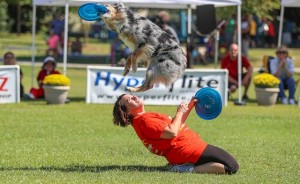If you’ve ever watched an agility competition, then you know how competitive the world of canine sports is. Canine athletes, like their human counterparts, go through rigorous training to compete at the highest level. Inevitably, the wear and tear of constant movement catches up with these athletes, leading to injury and time away from competition.
Once injury occurs, owners are faced with a tough choice – retire their canine athlete from the sport that drives them or rehabilitate their pet and pursue the sport while trying to minimize risk of re-injury. Luckily, recent advances in canine rehabilitation have made this choice a little easier, allowing canine athletes to recover faster and continue competing in the sports they love.
For Carolynn Williams, rehabilitation has allowed her dog Steele, a 9 year-old Australian Shepherd and 3-time Disc Dog World Champion, to continue his impressive career, bringing joy to the thousands of people who watch him perform.

Photo courtesy of Wayne Ramsay.
Carolynn (lead veterinary technician at Animal Medical Hospital at Glenwood, located in Maryland) remembers, “At about age 4, Steele began limping intermittently during training and competition. As you can imagine, training a dog on a World Championship status is repetitive, grueling and must be done pretty close to daily to maintain physical strength, endurance and conditioning.”
Seeking a solution that would allow Steele to continue competing, Carolynn took Steele for an evaluation with orthopedic specialists. Determining that “Steele suffered from a supraspinatus injury with impingement on his bicep tendon”, the specialist recommended a combination of rest, anti-inflammatories, conditioning and strength training. This regimen is challenging, as it requires striking balance between staying mobile enough to keep the tendons pliable while avoiding over-exertion and re-injury.

Anxious to help Steele feel better quickly, Carolynn began a comprehensive rehabilitation program. As part of Steele’s program, Carolynn opted to incorporate a therapeutic technology often used in rehabilitation settings to improve recovery outcomes.
The innovative technology, called laser therapy, is used in a wide range of veterinary practices to help reduce pain and inflammation and expedite the healing process. It is non-invasive and animals enjoy the soothing warmth generated. Given Steele’s recommended treatment path, this technology was a perfect fit and Carolynn has permanently incorporated this therapy into his ongoing rehabilitation.
After 3 years of continual training and rehabilitation, how is Steele doing now? Carolynn reports that, “He has maintained a very healthy level of strength and mobility in that shoulder and continues to compete at high levels in Flyball and Agility.” As for the laser therapy treatments, Carolynn is confident that they played a big role in his recovery: “I truly believe that with the assistance of laser therapy, Steele has been able to continue his competitive career comfortably and pain free.”

Photo courtesy of Jim Geiser at SeeGameTimePhotos.
To learn more about how this technology improves outcomes in canine athletes, read this article recently featured in Veterinary Practice News.



